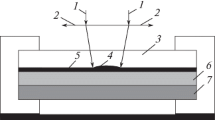Abstract
A two-dimensional numerical solution for pulsed laser transformation hardening is developed using the finite difference method (FDM). The FDM has been developed using Crank-Nicolson scheme which solved by using alternating-direction implicit method. If this present model was compared to the analytical solution, then the Crank-Nicolson scheme showed better results in terms of accuracy, consistency, stability, convergence, and performance than to the explicit scheme. The longer heating duration, higher laser beam intensity, and greater number of pulse had influences on increasing the maximum temperature. The repetitive heating had influences on extending the heat duration and increasing the initial temperature of domain. The shorter cooling duration in repetitive pulse produced higher maximum temperature. The thinner material’s thickness increased the cooling rate, which finally increased the possibility of austenite to transform into martensite phase. In addition, it was also found that the higher maximum temperature always reduced the cooling rate value when temperature cools down toward to the starting temperature of martensite formation. It reduced the possibility of martensite formation. It was also seen that the heat was conducted more effective to the axial direction than to the radial direction.

















Similar content being viewed by others
References
Wu W, Liang NG, Gan CH, Yu G (2006) Numerical investigation on laser transformation hardening with differential temporal pulse shape. Surf Coat Technol 200:2686–2694
Kaylon M, Yilbas BS (2006) Repetitive laser pulse heating analysis: pulse parameter variation effects on closed form solution. Appl Surf Sci 252:2242–2250
Shuja SZ, Yilbas BS, Shazli SZ (2007) Laser repetitive pulse heating influence of pulse duty on temperature rise. Heat Mass Transf 43:949–955
Rogers E (2006) Numerical analysis of heat conduction and phase transformation of steel slab due to laser beam interactions, Master Thesis, Rensselaer Polytechnic Institute, USA
Yilbas BS, Shuja SZ (1997) Heat transfer analysis of laser heated surfaces-conduction limited case. Appl Surf Sci 108:167–175
Singh V (1998) Heat treatment of metals, 1st edn. Standard Publishers Distributors, New Delhi
Gur CG, Pan J (2009) Handbook of thermal process modeling of steels. Taylor and Francis, Boca Raton
Totten E (2006) Steel heat treatment handbook, 2nd edn. Taylor and Francis, New York
Naqavi IZ (2001) Conduction and non-conduction limited laser heating process: mathematical simulation. Master Thesis, King Fahd University of Petroleum and Minerals, Saudi Arabia
Mamat M, Tofany N, Kartono A (2010) Numerical analysis of heat conduction and phase transformation in laser transformation hardening: influences of heating duration and laser beam intensity. Appl Math Sci 4(61):3019–3033
Mamat M, Tofany N, Kartono A (2010) Numerical modeling of laser surface hardening of steel with repetitive laser pulse. Far East J Math Sci (FJMS) 43(1):115–135
Chung TJ (2002) Computational fluid dynamics. Cambridge University Press, Cambridge
von Allmen M (1987) Laser-beam interactions with materials-physical principles and applications. Springer, Berlin
Incropera FP, DeWitt DP (2002) Fundamentals of heat and mass transfer, 5th edn. Wiley, Hoboken
Tannheill JC, Anderson DA, Pletcher RH (1997) Computational fluid mechanics and heat transfer, 2nd edn. McGraw- Hill, New York
Komanduri R, Hou ZB (2001) Thermal analysis of the laser surface transformation hardening process. Int J Heat Mass Transf 44:2845–2862
Acknowledgments
We would like to thank the Malaysia Government for funding this research through the Fundamental Research Grant Scheme (FRGS). We also would like to thank the reviewers so that our manuscript becomes better.
Author information
Authors and Affiliations
Corresponding author
Rights and permissions
About this article
Cite this article
Kartono, A., Tofany, N., Ahmad, M.F. et al. Applications of Crank-Nicolson method with ADI in laser transformation hardening. Heat Mass Transfer 48, 2041–2057 (2012). https://doi.org/10.1007/s00231-012-1044-4
Received:
Accepted:
Published:
Issue Date:
DOI: https://doi.org/10.1007/s00231-012-1044-4



